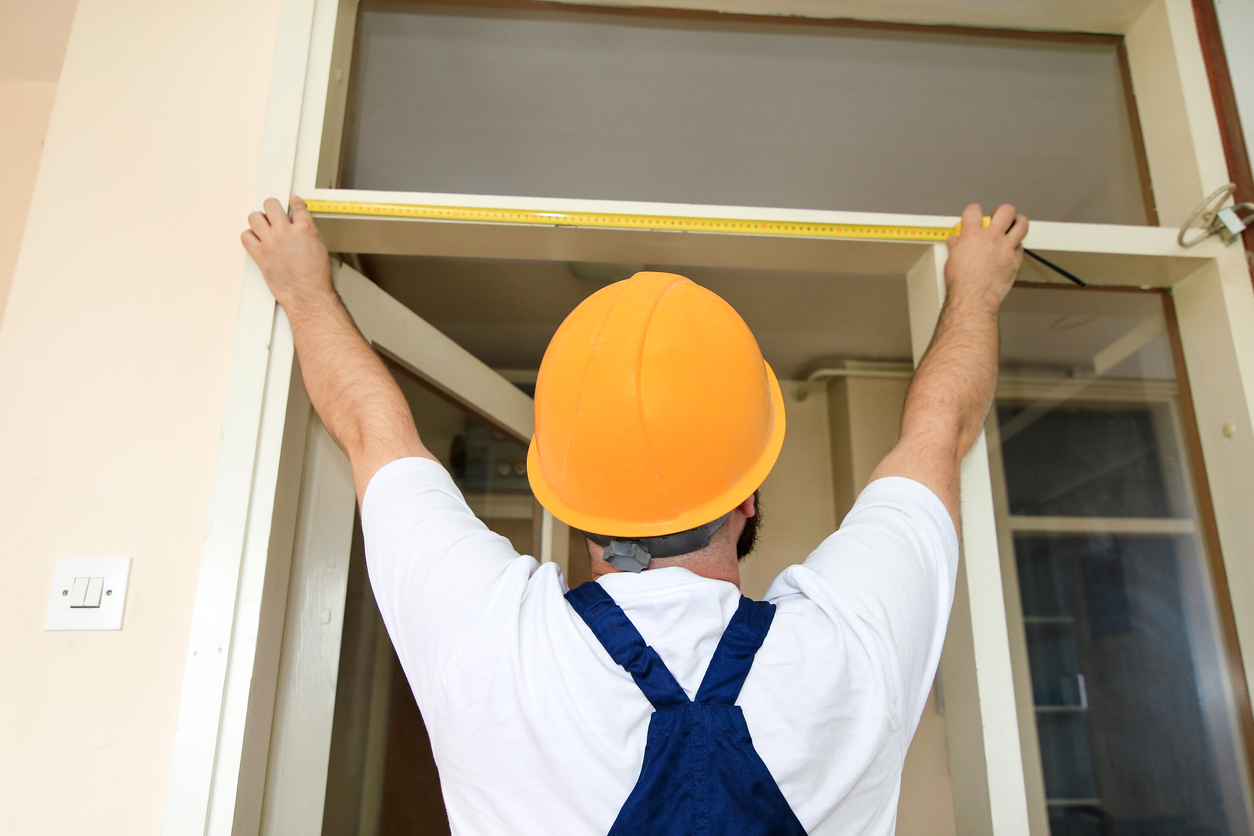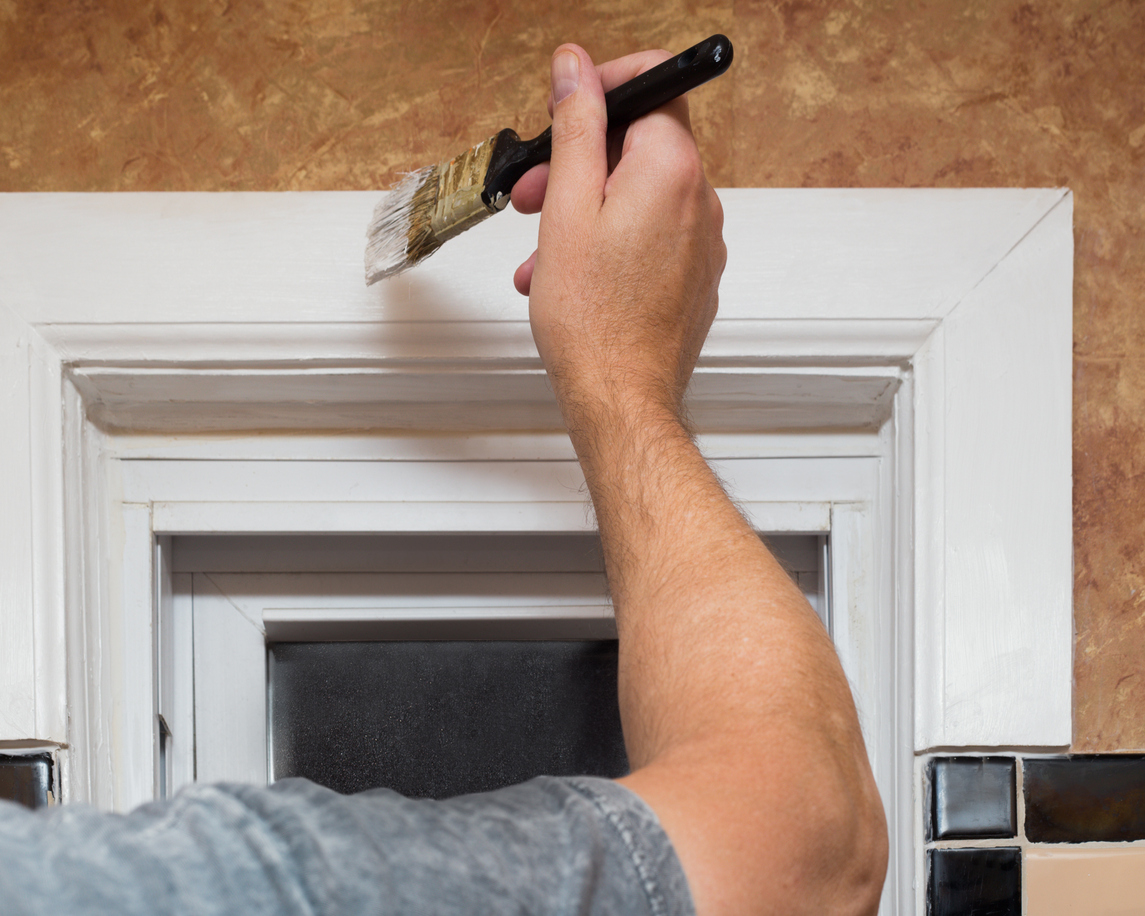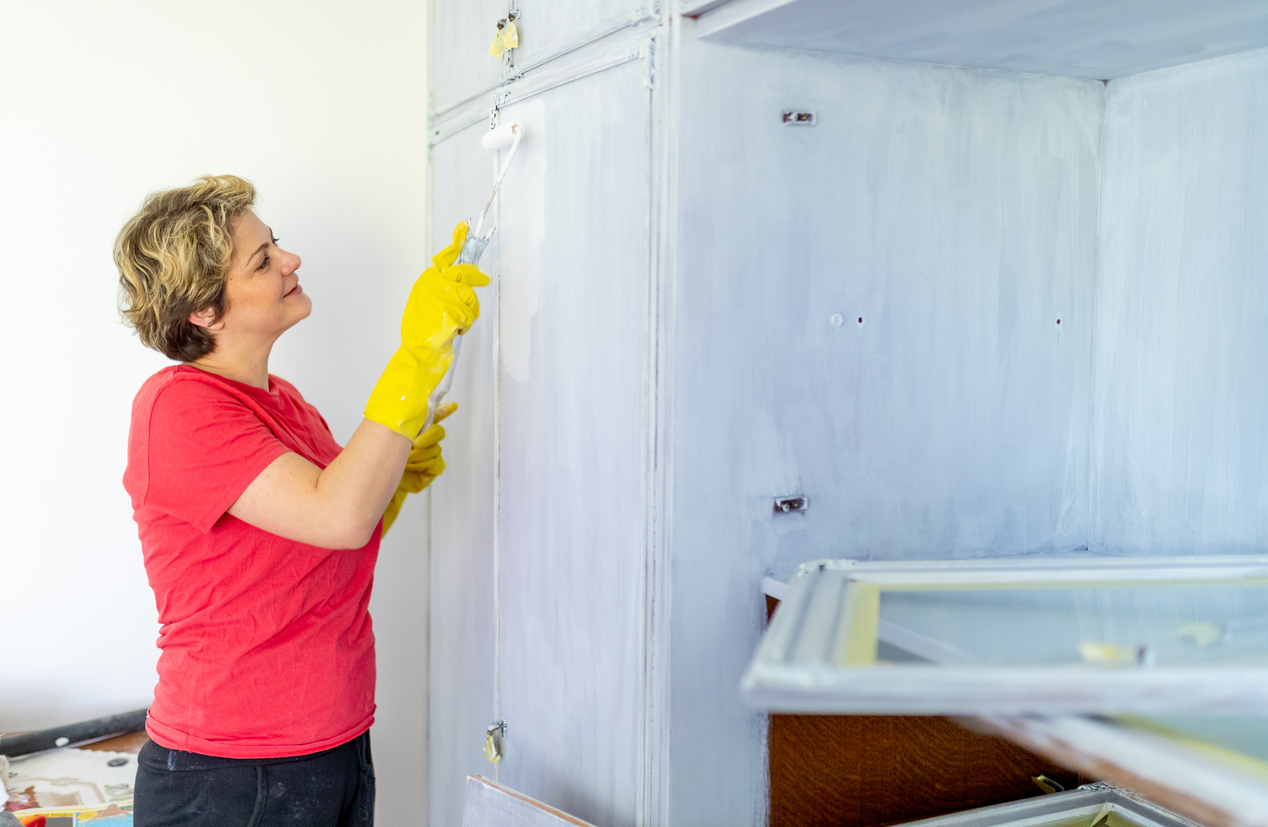We may earn revenue from the products available on this page and participate in affiliate programs. Learn More ›
Once you’ve conquered the somewhat Herculean challenge of choosing a paint color, the next order of business is to figure out how much paint to buy. It’s a tricky calculation, one that can be complicated by variables like your painting technique and the composition and condition of your walls. Doing the math, though, is the most accurate way to determine how much the project will cost and how much paint you’ll need.
As handy as they are, online paint calculators sacrifice precision for convenience. Doing your own math yields more accurate results, and all you need is a tape measure, a pencil, and a sheet of paper.
RELATED: How to Match Paint: Our Favorite High-Tech and Old-School Methods
Calculate the area of the surfaces you are painting.

Are you going to paint the ceiling? What about the baseboards? Once you know which surfaces you’re updating, determining how many gallons to buy is a simple matter of calculating the square footage of those surfaces. You should also plan for a second coat of paint, particularly if you’re painting a lighter color over a darker one. Here’s how to come up with an accurate estimate for how much paint you need to paint a room.
Calculate the area of the room’s solid walls.
Multiply the width by the height to get the total surface area of each wall.
width (ft) x height (ft) = square feet
For example, a solid wall that measures 12 feet wide by 10 feet high has an area of 120 square feet:
12 x 10 = 120 square feet
And say that you’ll also be painting second solid wall in the room, which is 10 feet wide by 10 feet high:
10 feet x 10 feet = 100 square feet
Those two walls together add up to 220 square feet.
120 + 100 = 220 square feet
Be sure to omit the trim—baseboards, crown molding, and so on—from your measurements, because you’ll probably be taping it off and painting it a different color.
Subtract the area of the windows.
Next, subtract the area of each window. (Measure just the window frame and the glass—leave out any molding.) If a 12-by-10-foot wall
12 x 10 = 120 square feet
has one 4-by-6-foot window
4 x 6 = 24 square feet
you’d subtract the area of the window from the total area of the wall.
120 – 24 = 96 square feet
The wall area that’s left to be painted is 96 square feet.
Subtract the area of any doors.
Presuming that you are not painting doors the same color as the walls, you’ll need to subtract the area of any doors in the room, just as you did for the windows. Measure the length and width of the wall and multiply those two measurements to get the wall’s square footage. Next, calculate the area of the door panel. If a 12-by-10-foot wall
12 x 10 = 120 square feet
has a door that measures 3 feet wide by 6 feet tall
3 x 6 = 18 square feet
you’ll subtract the area of the door from the area of the wall
120 – 18 = 102 square feet
leaving 102 square feet to be painted on that wall. Now, for the whole room, sum the total square footage of each wall minus its doors and windows.
wall square footage – window/door square footage = square footage to paint
Next, calculate how much paint you need to complete the project.

Now that you know the total surface area of the walls you’re painting, how many gallons of paint do you need to cover the entire room? How much does a gallon of paint cover? Well, that depends.
Manufacturers typically estimate the paint coverage per gallon at 250 to 400 square feet—a wide range, because different surfaces take paint in different ways. A gallon covers about 400 square feet of a smooth surface, like primed or prepainted drywall. If the surface is rough or textured, has never been painted before, or will be painted a color that’s very different from what’s already on the wall, that gallon may cover only 250 square feet.
Most of the best paint manufacturers’ calculators claim the higher range. For instance, Sherwin-Williams and PPG both estimate about 400 square feet of coverage per gallon, while Benjamin Moore’s and Behr’s calculators hover around 350 square feet per gallon.
Let’s say that you have 500 square feet of wall space to paint and a gallon of this particular manufacturer’s paint covers about 325 square feet. Because you want the best results for your paint finish, you’ll paint two coats:
500 x 2 = 1,000 square feet
And if the paint manufacturer says you’ll be able to paint 325 square feet per gallon, you’ll need
1,000 / 325 = 3.08 gallons of paint
It’s always a good idea to round up and purchase more paint than the math says you’ll need. You should always have some extra paint on hand for touch-ups. But rounding up to 4 gallons from 3.08 will leave you a ton of leftover paint—instead, you might consider buying 3 gallons and 1 quart.
How much ceiling paint do I need?

Chances are that you’ll be painting the ceiling a color that’s different than that of the walls. If that’s the case, simply measure the length and width of the ceiling and multiply the two measurements to find the square footage. If a bedroom ceiling is 100 square feet, you know that you need enough paint to cover at least that area.
A quart of paint typically covers about 100 square feet, so if you’re planning on painting one coat, you might be able to get away with buying just 1 quart of ceiling paint. If you’re painting two coats (and you probably should), you’ll need 2 quarts. The price of 2 quarts of paint is usually about the same as that of a gallon. It makes sense to spring for the gallon, particularly if you’re planning to use that ceiling color elsewhere in your home.
How much paint do I need for baseboards and window trim?

The above advice about ceiling paint also applies to trim. Assuming that you are going to paint your molding a color that’s different from what is on the walls, you’ll want to take separate measurements for the trim. Once you know how much surface area the trim covers, calculate how much paint you will need to give the trim two coats.
RELATED: Solved! The Best Paint for Trim and Baseboards
How much paint do I need for cabinets or furniture?

When painting kitchen cabinets or furniture, your first order of business is to figure out which surfaces you intend to refresh: Will you paint the backs of the doors as well as the fronts? Will you paint the shelves? Don’t start measuring until you have first settled the scope of the project.
The tricky part about painting cabinets and furniture is that you’ll be doing a lot more math, because you’ll have to sum multiple smaller measurements. For kitchen cabinets, start by measuring the surface area of the base cabinets. Add together the length of each run of base cabinets (including any end panels) and multiply it by the base cabinet height. Include the toe kick in the height measurement if you plan to paint it the same color as the cabinets.
In other words, if you have a run of base cabinets that measures 9 feet long and 3 feet high, then the surface area of the base cabinets is 27 square feet. Repeat this process for the upper cabinets and add the two figures together.
In the example above, if the base cabinets totaled 27 square feet and the upper cabinets measured 45 square feet, the total surface area would be 72 square feet.
27 + 45 = 72 square feet
If you’re painting the backs of the cabinet doors, double that figure (doubling here actually gives you a little more paint than you need because you won’t be painting the backs of the wood frame between the cabinet doors).
72 + 72 = 144 square feet
Calculate the surface area of the base cabinets’ sides. In this sample kitchen, the base cabinets are 1 foot deep and 3 feet high.
2 x (1 x 3) = 6 square feet
Calculate the surface area of the top cabinets’ two sides. In this example, our top cabinets are also 1 foot deep and 3 feet high.
2 x (1 x 3) = 6 square feet
Sum the surface area of the top and bottom sets of cabinets (and the backs of the doors), plus the sides of the cabinets.
72+ 72+ 6+ 6 = 156 square feet
Double the figure again to account for a second coat of paint.
156 + 156 = 312 square feet
Estimating a quart of paint coverage at about 100 square feet, you’d need a little more than 3 quarts to complete this painting project. Since a gallon of paint is cheaper than buying 4 quarts, you’re better off buying a whole gallon and saving whatever is left for touch-ups.
Note: Some homeowners may opt to paint the undersides of the top cabinets. If that’s the case in your situation, you’ll want to calculate the surface area of the undersides and add that to the other surface area calculations before doubling your total area to account for the second coat.
FAQs

If you’re still wondering how much paint you should buy for different projects around the house, here are some quick answers to a few common questions.
Q. How many coats of paint should you put on a wall?
You should generally count on two coats of paint. In some instances, you might get away with just one coat, particularly if you’re repainting with the same or a similar color. Usually, though, only a second coat can eliminate show-through and create a durable, even-looking finish.
Q. Do I have to prime before painting?
It’s almost always a good idea to prime first, and priming is a must when painting a lighter color over a darker color, or painting over new drywall or unfinished wood. That said, when using a color similar to the existing one and a paint that is similar chemically (latex over latex, for instance), you might be able to skip priming.
Q. How much does 2 gallons of paint cover?
As stated above, paint coverage per gallon ranges from 250 to 400 square feet. Two gallons of paint, then, would cover as much as 800 square feet. Keep in mind, however, that this figure can drop significantly if you’re covering walls that are in poor condition, rough textured, or porous.
Q. How many gallons of paint do I need for one room?
Use an online calculator or do your own calculations to determine how much paint to buy for a project. As a general rule of thumb, however, you can assume that 1 gallon can handle a small bathroom and 2 gallons is enough to provide two coats for a small- to average-size bedroom.

